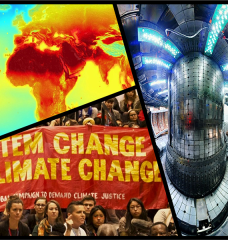
Before completing her undergraduate studies, Sophie Hartley, a student in MIT’s Graduate Program in Science Writing, had an epiphany that was years in the making.
“The classes I took in my last undergraduate semester changed my career goals, but it started with my grandfather,” she says when asked about what led her to science writing. She’d been studying comparative human development at the University of Chicago, which Hartley describes as “a combination of psychology and anthropology,” when she took courses in environmental writing and digital science communications.
“What if my life could be about learning more of life’s intricacies?” she thought.
Hartley’s grandfather introduced her to photography when she was younger, which helped her develop an appreciation for the natural world. Each summer, they would explore tide pools, overgrown forests, and his sprawling backyard. He gave her a camera and encouraged her to take pictures of anything interesting.
“Photography was a door into science journalism,” she notes. “It lets you capture the raw beauty of a moment and return to it later.”
Lasting impact through storytelling
Hartley spent time in Wisconsin and Vermont while growing up. That’s when she noticed a divide between rural communities and urban spaces. She wants to tell stories about communities that are less likely to be covered, and “connect them to people in cities who might not otherwise understand what’s happening and why.”
People have important roles to play in arresting climate change impacts, improving land management practices and policies, and taking better care of our natural resources, according to Hartley. Challenges related to conservation, land management, and farming affect us all, which is why she believes effective science writing is so important.
“We’re way more connected than we believe or understand,” Hartley says. “Climate change is creating problems throughout the entire agricultural supply chain.”
For her news writing course, Hartley wrote a story about how flooding in Vermont led to hay shortages, which impacted comestibles as diverse as goat cheese and beef. “When the hay can’t dry, it’s ruined,” she says. “That means cows and goats aren’t eating, which means they can’t produce our beef, milk, and cheese.”
Ultimately, Hartley believes her work can build compassion for others while also educating people about how everything we do affects nature and one another.
“The connective tissues between humans persist,” she said. “People who live in cities aren’t exempt from rural concerns.”
Creating connections with science writing
During her year-long study in the MIT Graduate Program in Science Writing, Hartley is also busy producing reporting for major news outlets.
Earlier this year, Hartley authored a piece for Ars Technica that explored ongoing efforts to develop technology aimed at preventing car collisions with kangaroos. As Hartley reported, given the unique and unpredictable behavior of kangaroos, vehicle animal detection systems have proven ineffective. That’s forced Australian communities to develop alternative solutions, such as virtual fencing, to keep kangaroos away from the roads.
In June, Hartley co-produced a story for GBH News with Hannah Richter, a fellow student in the science writing program. They reported on how and why officials at a new Peabody power plant are backtracking on an earlier pledge to run the facility on clean fuels.
The story was a collaboration between GBH News and the investigative journalism class in the science writing program. Hartley recalls wonderful experience working with Richter. “We were able to lean on each other’s strengths and learn from each other,” she says. “The piece took a long time to report and write, and it was helpful to have a friend and colleague to continuously motivate me when we would pick it back up after a while.”
Co-reporting can also help evenly divide what can sometimes become a massive workload, particularly with deeply, well-researched pieces like the Peabody story. “When there is so much research to do, it’s helpful to have another person to divvy up the work,” she continued. “It felt like everything was stronger and better, from the writing to the fact-checking, because we had two eyes on it during the reporting process.”
Hartley’s favorite piece in 2024 focused on beech leaf disease, a deadly pathogen devastating North American forests. Her story, which was later published in The Boston Globe Magazine, followed a team of four researchers racing to discover how the disease works. Beech leaf disease kills swiftly and en masse, leaving space for invasive species to thrive on forest floors. Her interest in land management and natural resources shines through in much of her work.
Local news organizations are an endangered species as newsrooms across America shed staff and increasingly rely on aggregated news accounts from larger organizations. What can be lost, however, are opportunities to tell small-scale stories with potentially large-scale impacts. “Small and rural accountability stories are being told less and less,” Hartley notes. “I think it’s important that communities are aware of what is happening around them, especially if it impacts them.”






